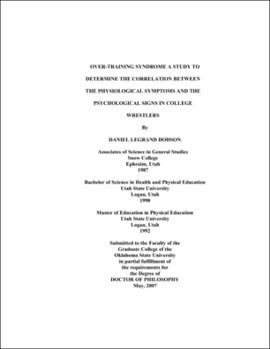| dc.contributor.advisor | Edwards, Steven W. | |
| dc.contributor.author | Dodson, Daniel Legrand | |
| dc.date.accessioned | 2013-11-26T08:34:23Z | |
| dc.date.available | 2013-11-26T08:34:23Z | |
| dc.date.issued | 2007-05 | |
| dc.identifier.uri | https://hdl.handle.net/11244/7372 | |
| dc.description.abstract | PURPOSE: The primary purpose of this study was to determine if there was a correlation between the physiological signs of over-training and the psychological signs of overtraining in collegiate wrestlers. METHOD: The RESTQ-Sport Questionnaire was used to evaluate the subjects' psychological recovery status. The salivary cortisol testing was used to measure the physiological response to training and recovery. The Recovery-Stress Questionnaire for Athletes was administered each time a saliva sample was obtained. The saliva collection protocol was followed in accordance with the guidelines prescribed by Salimetrics. Each subject was given a cup of water, and then instructed to thoroughly rinse his mouth by swishing one mouthful of water in the attempt to cleanse the teeth and mouth cavity of unwanted materials. The subjects were provided a 2 ml tube labeled with the subjects' identifying numbers. The subjects slowly expectorated 2 ml of unstimulated saliva. This process took approximately 10 minutes. The samples were placed upon ice until they were delivered to Cytovance Biologics LLC for testing. Salimetrics high sensitivity salivary cortisol enzyme immunoassay kit was strictly followed. The collection time was conducted at weekly intervals for 12 weeks to add sensitivity. RESULTS: The results of the present investigation revealed a non significant Pearson correlation coefficient between salivary cortisol concentration and RESTQ-Sport recovery stress scores for wrestlers during a season and post season of competition in collegiate wrestling. The calculated coefficient between cortisol and general stress (r = 0.248, p = .490) revealed a lack of association between these two variables. Further, statistically non-significant correlations were uncovered between salivary cortisol and general recovery (r = 0.159, p = .661), between cortisol and sports specific stress (r = 0.153, p = .673), and between cortisol and sports specific recovery (r = -0.119, p = .744). CONCLUSION: The data in this study demonstrated that there were changes in salivary cortisol, stress, and recovery scores as a result of competing in a competitive collegiate wrestling program. The relationship between salivary cortisol and stress-recovery scores appeared to be some what independent and unrelated. Further studies are necessary to determine if there is a relationship between physiological responses to over-training and psychological signs of over-training. | |
| dc.format | application/pdf | |
| dc.language | en_US | |
| dc.rights | Copyright is held by the author who has granted the Oklahoma State University Library the non-exclusive right to share this material in its institutional repository. Contact Digital Library Services at lib-dls@okstate.edu or 405-744-9161 for the permission policy on the use, reproduction or distribution of this material. | |
| dc.title | Over-training syndrome: A study to determine the correlation between the physiological symptoms and the psychological signs in college wrestlers | |
| dc.contributor.committeeMember | Kulling, Frank K. | |
| dc.contributor.committeeMember | Miller, Janice | |
| dc.contributor.committeeMember | Palmer-Hetzler, Tona | |
| osu.filename | Dodson_okstate_0664D_2187.pdf | |
| osu.accesstype | Open Access | |
| dc.type.genre | Dissertation | |
| dc.type.material | Text | |
| thesis.degree.discipline | Health, Leisure and Human Performance | |
| thesis.degree.grantor | Oklahoma State University | |
